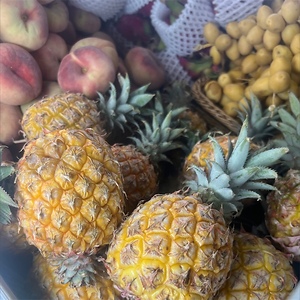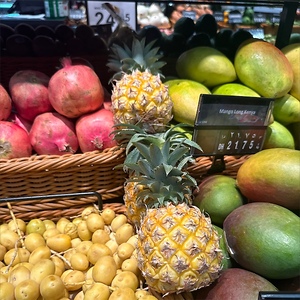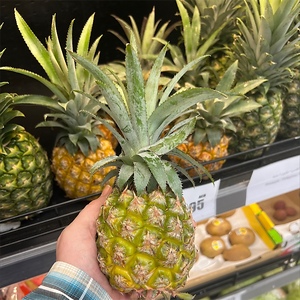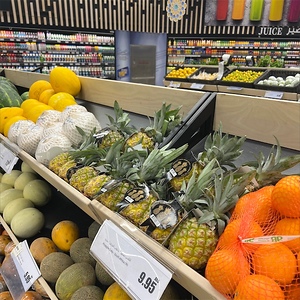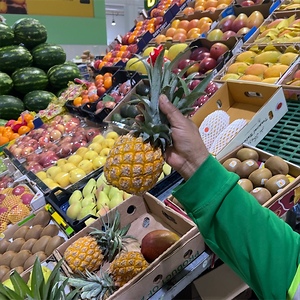


South African Baby Pineapples
Estimated Inventory, ea : 0
Description/Taste
South African Baby pineapples are small in size, averaging 10 to 12 centimeters in length and 7 to 8 centimeters in diameter, and have a round, oval, cylindrical shape. The sharp, spikey crown extends an additional 5 to 7 centimeters in length above the fruit, and the crown typically appears in shades of dusty green to dark green. Each leaf, also known as a frond, has serrated edges and is thick, firm, and fibrous, tapering to a point. The fruit's exterior is a rough, textured, fibrous rind covered in individual hexagonal segments fusing to form one surface. These segments are shallow and broad, allowing the rind to be easily sliced from the flesh without excess waste. The rind ripens from dark green to variegated golden yellow, yellow-orange, and yellow-brown hues and has a waxy, semi-rough feel. Underneath the rind, the vibrant yellow flesh is firm, aqueous, and tender, with a crunchy, succulent consistency. The central core is also edible and has a crisp, chewy texture. South African Baby pineapples are edible raw and release a fragrant, sweet, tropical, and honeyed scent. The fruit’s flesh is sweet and tangy with low acidity and has a rich, sugary, tart, fruity, and tropical taste.
Seasons/Availability
South African Baby pineapples are available year-round.
Current Facts
South African Baby pineapples, botanically classified as Ananas comosus, are a specialty variety belonging to the Bromeliaceae family. The petite pineapples are grown in South Africa and are commercially produced and promoted for their size, sweet taste, low waste, and novelty. South African Baby pineapples are also known as Baby Queen pineapples, Baby Queen Victoria pineapples, Zululand pineapples, and Zululand Queen Baby pineapples. It is important to note that South African Baby pineapples are full-grown despite their size. The fruits are harvested ripe and are a variety that only grows to a small size. South African Baby pineapples have become popular in international markets as they are an ideal individual serving size. The fruits are exported worldwide, and consumers favor the variety for their edible core, allowing the entire flesh to be eaten, reducing food waste. South African Baby pineapples are a premium variety and are primarily consumed fresh as a delicacy. The variety has a bright, sweet, and tangy taste, and the fruits are often kept somewhat intact to highlight their small size in raw or cooked culinary preparations.
Nutritional Value
South African Baby pineapples have not been extensively studied for their nutritional properties. Since the pineapples are full-grown, they are thought to share similar nutrients to other commercial varieties, including fiber to regulate the digestive tract, potassium to balance fluid levels within the body, and calcium to build strong bones and teeth. South African Baby pineapples also provide vitamin C to strengthen the immune system, vitamin A to maintain healthy organ functioning, vitamin E to protect the cells against free radical damage, and other amounts of manganese, iron, magnesium, and B vitamins.
Applications
South African Baby pineapples have a sweet-tart taste suited for fresh and cooked preparations. The fruits should be sliced to remove their skin, but once prepped, both the flesh and the core are edible, creating a low-waste meal. South African Baby pineapples can be sliced into green salads and fruit medleys, diced into salsas, ceviche, and dips, or cut and used as a topping over rice dishes, seafood, and desserts. One of the distinct methods of serving the small fruits is removing the skin but leaving the crown attached. The entire pineapple can be sliced into spears, and the piece of the crown attached can be used as a handle to eat the spear. This is a popular serving method at parties. South African Baby pineapples can also be halved, hollowed, and filled with fruit, tuna salad, rice, or grilled meats, or they can be blended into juices, smoothies, and shakes. In addition to fresh preparations, South African Baby pineapples can be sliced into rings and grilled to develop a caramelized surface. They can also be incorporated into baked goods and desserts such as cakes, muffins, and crisps. While less common, consumers have mentioned that they keep South African Baby pineapples whole and place them as table centerpieces. When the event is finished, guests are invited to take a baby pineapple home. South African Baby pineapples pair well with vanilla, maple syrup, chocolate, herbs such as mint, basil, and tarragon, fruits including strawberries, mangoes, and coconut, and meats such as pork, beef, poultry, and fish. Whole, unopened South African Baby pineapples will keep for 7 to 10 days when stored in a cool, dry, and dark place, such as the refrigerator.
Ethnic/Cultural Info
The name baby pineapple is a misnomer as the fruits are not harvested prematurely. Baby pineapples are gathered from plants when they have reached maturity, and their small nature is actually their full-grown size. There are several cultivars planted worldwide that are categorized as baby pineapples, and these fruits are naturally smaller than the common pineapples seen in commercial markets. Despite their petite stature, South African Baby pineapples are prized as a delicacy in international markets and are commercially grown as a premium variety. Pineapple production in South Africa has become an important agricultural sector, and this can be seen by the construction of the world’s tallest pineapple building. This pineapple-shaped, multi-story building was erected in Bathurst, a town in the Eastern Cape Province of South Africa, and reaches over seventeen meters in height. The building was built by the local farming community in the 1980s and was affectionately referred to as the Big Pineapple of Bathurst. During the 1980s, Bathurst farmers struggled to successfully grow crops until the introduction of the pineapple. Local growers were overjoyed with the fruit’s success, and the pineapple-shaped building was built in homage to the cherished plant. The Big Pineapple is made from metal and fiberglass and houses three floors, including a gift shop, museum, and observation platform. It has become a popular tourist attraction in the area, and an experimental pineapple farm surrounds the building.
Geography/History
South African Baby pineapples are descendants of ancient pineapple varieties native to South America. Experts believe pineapples were spread worldwide through explorers and trade in the 16th and 17th centuries, and over time, plantations were established for breeding and commercially growing the fruits. Pineapples were said to have been introduced to regions in South Africa in the late 19th century and were first planted in the KwaZulu-Natal Province in the Hluhluwe District. Later on, cultivation spread into the Eastern Cape, mainly the Bathurst area. Much of the history of South African Baby pineapples is unknown, but some research points to their creation in the 1960s or 1980s. In the early 21st century, South African Baby pineapples were commercially grown and exported to countries worldwide as a specialty product. Today, South African Baby pineapples thrive in hot and humid climates of South Africa and are sold on a small scale domestically through local markets and roadside stands. The variety is most commonly exported, especially to the United Arab Emirates, the United States, Australia, and parts of Asia and Europe. The South African Baby pineapples featured in the photograph above were sourced through the Waterfront Market in Dubai.



